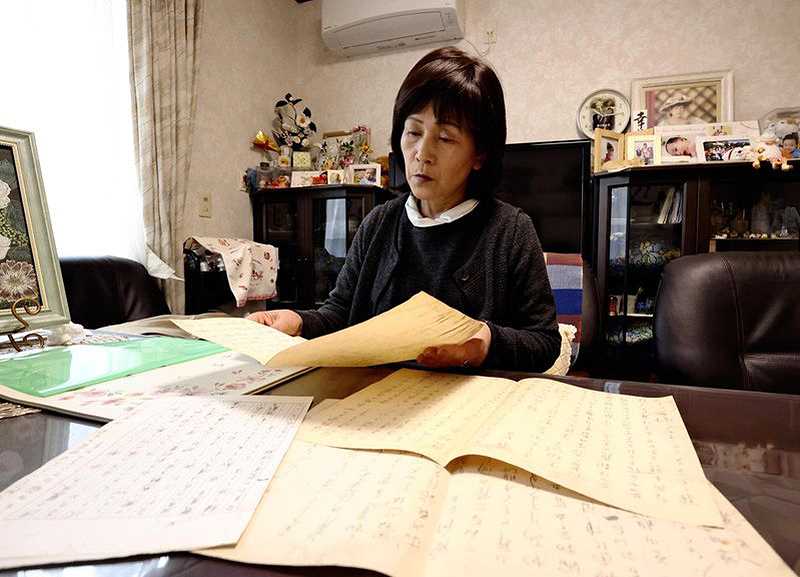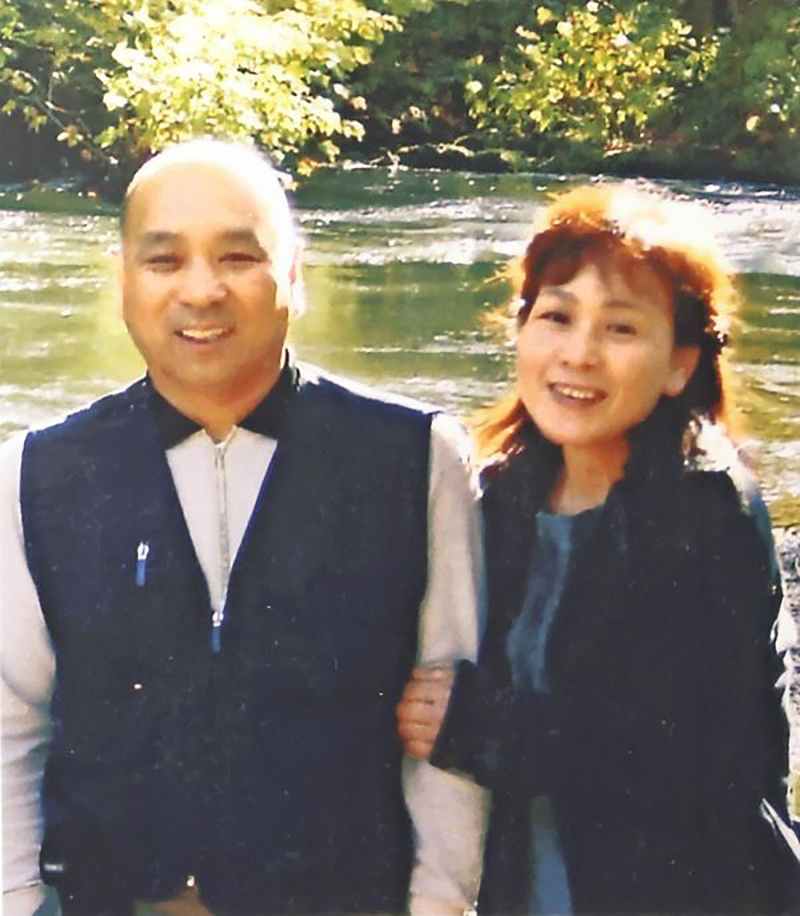
Miyoko Yamauchi looks at writings by her late husband Yoshikatsu at their home in Minami-Sanriku, Miyagi Prefecture, on March 3.
18:53 JST, March 10, 2022
The words engraved on the gravestone in a sunlit cemetery in Minami-Sanriku, Miyagi Prefecture, capture the mood that has pervaded the Tohoku region since the Great East Japan Earthquake left it devastated 11 years ago today.
“The horror of disaster, the importance of life. Praying that the ‘bosai’ that means to prevent disasters will not become the ‘bosai’ that means to forget disasters.” The Chinese characters for “bo” are different in these homonyms.
The grave is the final resting place for Yoshikatsu Yamauchi. A member of the Minami-Sanriku Fire Station, he was helping lead people to safety after the earthquake hit on March 11, 2011, but died in the subsequent tsunami. He was 58.
The message on the gravestone is a passage that he had composed and was found in a bag he had with him on the day of the disaster. When he was young, he had written the text in regard to a tsunami triggered by a Chilean earthquake in 1960. The muddy paper still bears blurry lines of red ink where he highlighted parts.
“I thought this was what he wanted to convey,” his wife, Miyoko, said as she recalled Yoshikatsu carrying the text with him. She decided to engrave the passage onto his gravestone.
Her last memory of her husband was seeing him rush from their home that day as he answered the call of duty without a moment’s hesitation.

Yoshikatsu and Miyoko Yamauchi are seen during a trip around 2003.
Eleven years ago on March 11, Yoshikatsu was at home as it was his day off. Their house in the Utatsu Kamisawa district of town is located in the mountains about five kilometers from the coast. The tsunami caused no damage there.
When the earthquake struck at 2:46 p.m., the couple had just finished getting dressed in preparation for a visit to their daughter, who was living about two hours away by car. After the initial strong tremors stopped, Yoshikatsu changed into his firefighting uniform. “I’m going to the firehouse,” he said, then took the car down the mountain.
Miyoko had no doubt that he would return safely. A few days later, she was helping distribute food at Utatsu Junior High School, which had been transformed into an evacuation site, when a rumor reached her ears. “There are firefighters who can’t be reached.”
The town hall had taken a direct hit from the tsunami and was in ruins. A number of communities were left isolated, and she did not yet know that the Minami-Sanriku Fire Station had been swept away.
“My husband is alright, isn’t he?” Miyoko asked a fellow firefighter whom she came across. “He’s OK, he’s OK,” was the reply. But she felt something was not right, like he had turned his eyes away from her. As the days passed by and Yoshikatsu remained unaccounted for, his colleagues and others lowered their eyes when they saw her.

Yoshikatsu’s gravestone, inscribed with a passage on treasuring life that he composed, is seen in Minami-Sanriku, Miyagi Prefecture, on March 3.
Yoshikatsu’s body was found in late March. Miyoko asked police to allow her to take his body home so she could spend at least one night with him before he was cremated.
Miyoko was 22 when they married, and the couple raised two sons and a daughter. Yoshikatsu was five years older than her and had a strong sense of fairness. He was well-liked by his colleagues. He could not hold his liquor very well, and would stagger when drunk. But when anyone tried to take his arm to help him, he would gruffly spurn them, saying, “You don’t need to do that.”
Among Miyoko’s most cherished memories with him is a trip they took two years before the disaster to a nearby mountain to see the blooming azaleas. On their walk back, Yoshikatsu gently took hold of her hand.
She was happy, but also found it odd. As she looked inquiringly at her husband, he blushed and said, “This is nursing care.” She asked, “Is this nursing care?” “Yes, nursing care,” he insisted. They walked slowly down the mountain path enjoying such exchanges.
Yoshikatsu was among nine firefighters in Minami-Sanriku who died in the disaster.
Initially, Miyoko could not understand why they had to be sacrificed. At a meeting for bereaved families in the summer of 2011, she castigated the fire chief and other officials. “Why didn’t you tell them to flee?”
With time, her feelings changed as she learned more about what her husband was like at work through exchanges in a group for bereaved families of firefighters and from colleagues who visited her home to mourn him.
Yoshikatsu took pride in his work and had backbone, never hesitating to express his opinion on matters that he felt were not right, even to his boss. An acquaintance told Miyoko that a relative said, “I was saved by Yoshikatsu.” According to the acquaintance, Yoshikatsu was standing in the street with arms raised, stopping cars heading toward the coast when the tsunami swallowed him from behind.
“He was trying to help every last person he could until the last moment,” Miyoko said.
Since November 2019, Miyoko has been serving as a welfare worker in the district. When heavy rains or other potential disasters hit, she visits or calls elderly residents to make sure they are safe, all the while keeping in mind the message left by Yoshikatsu.
“Life is more important than anything else,” she said. “As I am mutually helped by others, I want to play a role to preserve that notion.”
She knows Yoshikatsu is watching over her.
Victims in the line of duty
In Iwate and Miyagi prefectures, a total of 27 firefighters and rescue personnel were killed or went missing in the Great East Japan Earthquake, according to the Fire and Disaster Management Agency of the Internal Affairs and Communications Ministry.
By fire department, the Kesennuma-Motoyoshi Fire Department, which includes the Minami-Sanriku Fire Station in its jurisdiction, had the most victims with 10. In Iwate, Miyagi and Fukushima prefectures, a total of 254 volunteer firefighters died or went missing.
In the wake of the disaster, the agency issued a notice in 2012 on safety management in future crises. It calls for fire station members and volunteer firefighters to evacuate themselves when they feel their own lives are in danger.
"Society" POPULAR ARTICLE
-

M4.9 Earthquake Hits Tokyo, Neighboring Prefectures
-

M7.5 Earthquake Hits Northern Japan; Tsunami Waves Observed in Hokkaido, Aomori and Iwate Prefectures
-

Tsukiji Market Urges Tourists to Avoid Visiting in Year-End
-

Israeli Tourists Refused Accommodation at Hotel in Japan’s Nagano Pref., Prompting Protest by Israeli Embassy and Probe by Prefecture
-

M5.7 Earthquake Hits Japan’s Kumamoto Pref., Measuring Upper 5 Intensity, No Tsunami Expected
JN ACCESS RANKING
-

Keidanren Chairman Yoshinobu Tsutsui Visits Kashiwazaki-Kariwa Nuclear Power Plant; Inspects New Emergency Safety System
-

Imports of Rare Earths from China Facing Delays, May Be Caused by Deterioration of Japan-China Relations
-

University of Tokyo Professor Discusses Japanese Economic Security in Interview Ahead of Forum
-

Japan Pulls out of Vietnam Nuclear Project, Complicating Hanoi’s Power Plans
-

Govt Aims to Expand NISA Program Lineup, Abolish Age Restriction






















